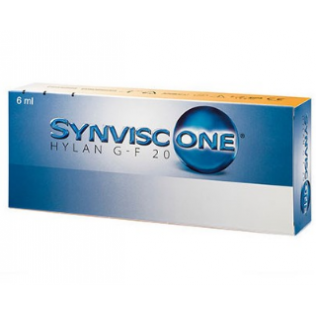Description
The row G-F 20 is available in two presentations:
· Synvisc ® (presentation of 2 ml)
· Synvisc-One ® (presentation of 6 ml)
Hilano G-F 20 is an elastoviscose fluid, sterile and apyrogen, which contains hylans. Hilans are products derived from hialuronate (sodium hyaluronic acid salt), made of repeated N-acetilglucosamine dysaccharides and sodium glucuronate. Hilano a has an average molecular weight of approximately 6,000.000 and hilano b is a hydrated gel. Hilane G-F 20 contains hilane to and hilane b (8.0 mg ± 2.0 mg per ml) in sodium physiological solution (ph 7.2 ± 0.3).
Features
Hilane G-F 20 is biologically similar to hialuronate. Hyaluronate is a component of the synovial fluid responsible for its elastoviscosity. However, the mechanical properties (elastoviscos) of the G-F 20 hilan are superior to those of the synovial fluid and comparable concentration hialuronate solutions. the hilano G-F 20 has a elasticity (G storage module) to 2.5 hz of 111 ± 13 pascales (pa) and a viscosity (g? loss module ) of 25 ± 2 pa. elasticity and viscosity of the synovial fluid of the human knee from 18 to 27 years old measures with a method comparable to 2.5 hz are G = 117 ± 13 pa and 8? the degradation of hylans in the organism follows the same pathway as hialuronate and so degradation products lack toxicity.
Indications and mode of employment
Hilano G-F 20:
· temporarily replace and supplement the synovial fluid.
· is effective in any stage of joint pathology.
· is particularly effective in patients who actively and regularly use the affected joint.
· its therapeutic effect is due to viscosuplementation, a process by which the physiological and reological state of the tissues of the joint is restored with osteoarthritis.
The viscosuplementation that is achieved by treatment with hilanus G-F 20 decreases pain and discomfort, allowing a greater range of movement of the joint. in vitro have shown that hilane G-F 20 protects cartilage cells against certain physical and chemical lesions.
Synvisc has been conceived exclusively for intraarticular application by a doctor, for the treatment of pain associated with knee osteoarthritis, hip, ankle and shoulder.
Synvisc-One has been conceived exclusively for intraarticular application by a doctor for the treatment of pain associated with knee osteoarthritis.
Contraindications
· Hylane G-F 20 should not be injected into the joint when there is venous or lymphatic stasis in the respective member.
· Hilane G-F 20 should not be used in infected or intensely swollen joints or in patients suffering from skin diseases or infections in the area of injection application.
Warnings
· do not inject intravascularly.
· do not inject extraarticularly or within the tissues and the synovial capsule. adverse effects, usually in the injection area, have occurred after extraarticular injection of Synvisc. .
· should not be used together with disinfectants containing quaternary amonic salts for the preparation of the skin as the hialuronate can be precipitated in its presence.
Precautions
· Hilano G-F 20 should not be used if a large intraarticular exudate is produced prior to injection.
· as in any process of joint invasion, the patient is recommended to avoid any intense physical activity after intraarticular injection and to continue with the usual activities spent a few days.
· Hilano G-F 20 has not been tested in pregnant women or under 18 years of age.
· Hilane G-F 20 contains small amounts of avian protein, so it should not be used in patients with hypersensitivity to that protein.
Adverse effects
· adverse effects that affect the injected member: transient pain, swelling, and/or exudation in the injected joint after G-F 20 intraarticular injections. After intraarticular injection of synvisc or Synvisc-One cases of acute inflammation have been reported, characterized by pain, swelling, exudation and sometimes heat and/or stiffness in the joint. In the analysis of the synovial fluid the existence of aseptic liquid without crystals is noted. This reaction usually occurs in a few days as a response to the treatment of nonsteroidal anti-inflammatory drugs (aine,) intraarticular steroids and/or arthrosthesis. the clinical benefit of the treatment is evident after such reactions.
· Synvisc/Synvisc-One clinical trials have not evidenced any intraarticular infection and few cases have been reported during the clinical use of synvisc.
· Hypersensitivity reactions have also been reported, including anaphylactic reaction, anaphylactic shock, and angioedema. Experience after marketing has identified the following systemic effects that seldom appear with the administration of SynviscRash, hives, itching, fever, nausea, headache, dizziness, chills, cramps, paresthesia, peripheral edema, malaise, breathing difficulties, facial redness and swelling.
- In controlled clinical trials with Synvisc there was no statistically significant difference in the number of systemic adverse effects between the group of patients who received Synvisc and the one that received control treatments.
· in controlled clinical trials Synvisc-One It was noted that the type of adverse effects that occurred and the frequency at which they were detected were similar in the group of patients who received Synvisc-One and the group treated with placebo.
Dosage and administration
· do not use the G-F 20 row if the container is open or damaged.
· use the syringe content immediately after opening the container.
· remove the synovial fluid or exudate before injecting G-F 20.
· Injection should be made at room temperature.
· to remove the syringe from the container (or tray) hold it through the body without touching the piston.
· The administration must be carried out in aseptic conditions, with special care when opening the plug of the tip of the syringe.
· turn the gray plug before pulling it to avoid product losses.
· use an appropriate size needle:
· Synvisc, calibre 18-22
Choose a needle of appropriate length depending on the joint you are going to treat.
· Synvisc-One, calibre 18-20
· to ensure a hermetic sealing and prevent losses during administration, secure the needle correctly while firmly holding the syringe's luer adapter.
· Do not overly tighten or lever when fixing the needle or removing its protector, as the tip of the syringe may be broken.
· inject only into the synovial space by resorting, if necessary, to appropriate orientation, such as fluoroscopy, especially in joints such as the hip and shoulder.
· the content of the syringe is for a single use. recommended dosing instructions indicate that the full volume of the syringe (2 ml for synvisc and 6 ml for Synvisc-One) should be injected.
· do not reuse the syringe or needle. reuse of syringes, needles and/or any product of a syringe can compromise the sterility of the product, cause its contamination and/or harm treatment.
· When using fluoroscopic guide, you can use an ionic or non-ionic contrast agent. no more than 1 ml contrast agent should be used for each 2 ml G-F 20.
· Do not re-sterilize hilane G-F 20.
Postology and recommended maximum dose
The G-F 20 yarn dose regimen depends on the joint being treated.
Knee osteoarthritis:
Synvisc
the recommended treatment regime consists of a series of three injections of 2 ml on the knee, with a week of separation between them. for maximum effect, the administration of the complete series is essential, i.e. the three injections. the recommended maximum dose is six injections in 6 months and with a minimum of 4 weeks between treatment regimens.
Synvisc-One
the recommended treatment regimen is a 6 ml injection in the knee, which can be repeated at 6 months if the patient's symptoms require it.
Hip osteoarthritis / ankle / shoulder:
Synvisc
the recommended initial treatment regimen is a single 2 ml injection. However, if the appropriate symptomatic relief is not achieved after that injection, a second 2 ml injection is recommended. clinical data have shown that patients benefit from this second injection if administered between one and three months after the first.
Duration of the effect
Treatment with G-F 20 spinal cord only affects the injected joint, does not produce general systemic effects.
Synvisc
In general, it has been reported that the duration of the effect in patients responding to treatment is up to 26 weeks, although shorter and longer periods have been observed. However, prospective clinical data for patients with knee osteoarthritis have shown that, after applying a single set of three injections Synvisc , the benefits of treatment have been extended to 52 weeks.
Synvisc-One
Data from some prospective clinical trials in patients with knee osteoarthritis have shown a pain reduction up to 52 weeks after a single injection Synvisc-One in addition to improvements related to stiffness and functional capacity.
The clinical data of a controlled, randomized, double-blind trial in patients with knee osteoarthritis have shown a statistically and clinically significant reduction of pain compared to placebo. a total of 253 patients (124 received Synvisc-One and 129 received placebo.) in the course of 26 weeks, patients who had received Synvisc-One showed a percentage change in pain in relation to the initial value of 36 %, while patients in the group that received placebo presented a percentage change in pain in relation to the initial value of 29.%.
Other prospective clinical data from two open multicenter studies in patients with knee osteoarthritis have shown statistically significant improvements in pain relief compared to the initial value up to 52 weeks after a single administration of Synvisc-One . in the first study, 394 patients received Synvisc-One They showed a statistically significant change in the womac a1 subpoint (walk pain) (-28 ±19.89 mm in a 100 mm eva) in relation to the initial value for 26 weeks. In addition, statistically significant changes were observed in relation to the initial value in womac a1, womac a, b and c scores in the six periods of observation between weeks 1 and 52, which shows improvements in pain when walking and pain (womac a1: -32.7 ±19.95 mm; womac a: -29.18 ±19.155 mm, womac0.
In the second study, 571 patients received Synvisc-One They showed a statistically significant improvement in pain for 26 weeks, according to measurement through a verbal pain questionnaire (verbal pain questionnaire, vpq.) the average pain assessment improved from 3.20 at the beginning to 2.24 at the week 26 visit and 64.6 % of patients received pain relief. the secondary valuation criteria showed a statistically significant improvement in the vpq scores at all times of observation from week 1 to 52, with vpq scores down from 3.20 at the start to 2.26 at the visit of the week 52. 61.5 % of patients received pain relief.
Content per ml (hilano G-F 20)
1 ml Synvisc contains: hilanus 8.0 mg; sodium chloride 8.5 mg; hydrogenated dysphoto 0.16 mg; dihydrogenated sodium phosphate 0.04 mg; c.s injection water.
Presentation
The content of each syringe is sterile and apyrogen. conserve at a temperature between 2°C and 30°C. do not freeze.
Synvisc is presented in glass syringes of 2.25 ml, containing 2 ml G-F 20.
Synvisc-One is supplied in a 10 ml glass syringe with 6 ml G-F 20.













